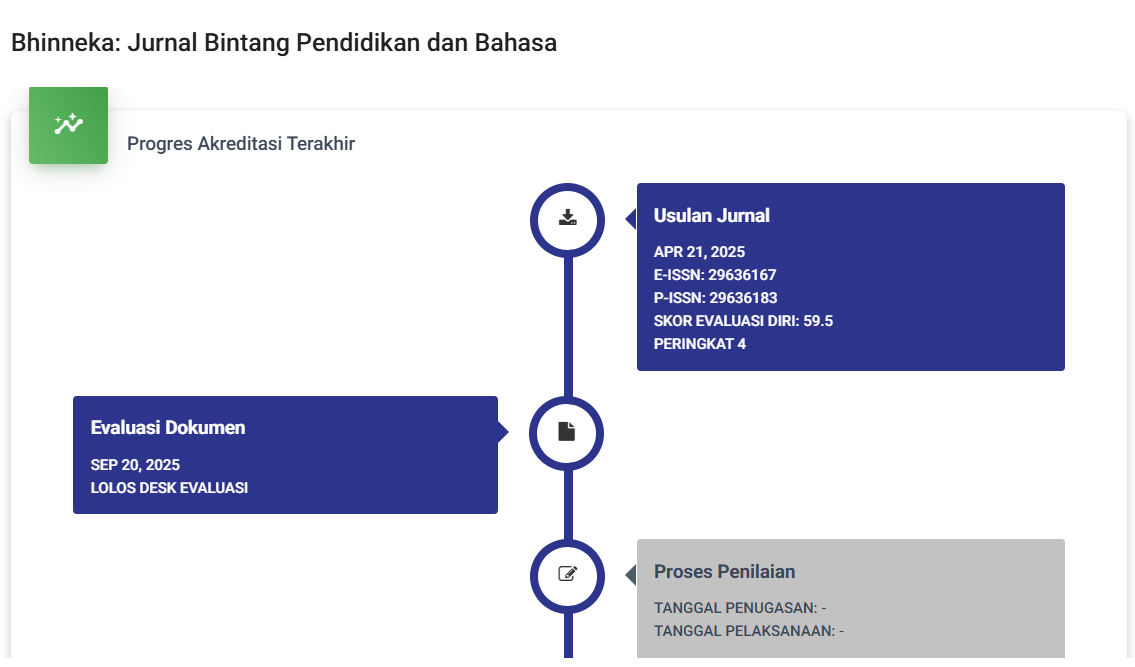Analisis Puisi “Kesabaran” Karya Chairil Anwar Dengan Pendekatan Stuktural
DOI:
https://doi.org/10.59024/bhinneka.v1i3.190Keywords:
Literary Appreciation, Literary Works, Poetry, Structural Approach, Physical Structure, Inner StructureAbstract
The poem "Patience" by Chairil Anwar became one of the literary works that inspired many people. This poem describes one's patience and sincerity in facing life's trials. This paper aims to provide an appreciation analysis of the poem "Patience" by Chairil Anwar. This analysis is carried out by paying attention to the structure, language, and meaning contained in the poem. In this analysis, the writer finds that the structure of the poem "Patience" consists of four stanzas with each stanza consisting of four lines. In each of his verses, Chairil Anwar emphasizes the message of patience and sincerity in facing life's trials. The language used by Chairil Anwar in this poem is very effective in conveying philosophical messages about patience and sincerity. Chairil Anwar uses simple language but full of deep meaning. The meaning contained in the poem "Patience" is about one's patience and sincerity in facing life's trials. Chairil Anwar described that patience and sincerity are two very important things in life. Even though life is full of trials and tribulations, with patience and sincerity, humans are able to face all of that with steadfastness. It can be concluded that the poem "Patience" by Chairil Anwar is a very valuable literary work. This poem is able to describe philosophical messages about patience and sincerity in simple yet meaningful language. Through this poem, Chairil Anwar inspires readers to always be patient and stay strong in facing all of life's trials.
References
Anwar, Chairil. (1949). Kesabaran. Jakarta: Balai Pustaka.
Balfas, Muhammad. (1994). Chairil Anwar: Suara dan Puisi. Jakarta: Pustaka Jaya. Bakri Siregar, S. (1973). Chairil Anwar dan Tiga Kawan. Jakarta: Pustaka Jaya.
Diah, Ariani. (2009). Analisis Wacana pada Puisi-puisi Chairil Anwar. Jurnal Ilmu Budaya, Vol. 12, No. 1, pp. 41-53.
Effendi, Bahtiar. (1983). Chairil Anwar: Sebuah Pengantar. Jakarta: Pustaka Jaya. Isnaini, H., & Lestari, R. D. (2022). Hawa, Taman, dan Cinta: Metafora Religiositas pada Puisi-Puisi Sapardi Djoko Damono. Jurnal Gurindam: UIN Sultan Syarif Kasim Riau, Volume 2, Nomor 2, 1-14.
Isnaini, H., Sudaryati, S., Taufik, M., Puspidalia, Y. S., & Arianto, T. (2023). Teori Sastra: Global Eksekutif Teknologi.
Kurniawan, E. (2017). Tinjauan Semiotika pada Puisi Kesabaran Karya Chairil Anwar. Jurnal Pendidikan Bahasa dan Sastra, Vol. 17, No. 2, pp. 145-154.
Siregar, Bakri. (1982). Chairil Anwar: Sebuah Pemahaman Kreatif. Jakarta: Grafiti Pers. Soepanto, Johny. (2010). Chairil Anwar: Sebuah Puisi Kebangsaan. Jakarta: Kepustakaan
Populer Gramedia.
Suryana, A. (2018). Analisis Struktur Puisi "Kesabaran" Karya Chairil Anwar. Jurnal Lingua Idea, Vol. 2, No. 1, pp. 35-46.
Teeuw, A. (1980). Sastra Baru Indonesia. Jakarta: Pustaka Jaya.
Panjaitan, S. (2011). Teori Sastra: Apresiasi dan Pengantar Komprehensif. Jakarta: Bumi Aksara.
Shahab, A. (1998). Apresiasi Puisi. Jakarta: Pustaka Firdaus.
Suryawin, P. C., Wijaya, M., & Isnaini, H. (2022). Tindak Tutur (Speech Act) dan Implikatur dalam Penggunaan Bahasa. Sinar Dunia: Jurnal Riset Sosial Humaniiora dan Ilmu Pendidikan, Volume 1, Nomor 3, 29-36.








